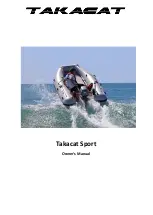
Once a year
(Performed by a qualified marine technician)
•
Inspect boat receptacles for any signs of deterioration, including
cord wear, loose connections, signs of sparking or overheating
and bent or pitted blades. If there are any such signs, examine,
correct, and test the equipment or replace it.
Galvanic Isolator
A galvanic isolator is installed in your boat and electrically con-
nected between the boat’s AC panel ground and the dockside AC
ground wire. The galvanic isolator is designed to permit AC ground
currents to pass safely between the boat and the dockside but to
block the small DC currents that flow in seawater between boats in
a marina because of different metals on the boats that are in the
water. When the shore power cord is connected to the boat and
breaker, the green light on the panel should be on.
FUEL SYSTEM
The internal fuel system on your Chaparral boat meets all current
Federal requirements.
Fuel lines, filters, and all fuel system components should be
checked at the start of each season and periodically thereafter, par-
ticularly after any work has been done aboard the boat which might
have affected any part of the system. Be certain that all are in
proper condition and that the entire system is fuel tight.
The fuel tank is located forward of the engine compartment under
the cockpit floor. The fuel tank fill pipe is located on the outside
deck. Some models have a dual fuel system, providing convenience
and flexibility of refilling your fuel tank from either side of the boat.
The fuel tank vent allows air to escape as the tank is being filled and
helps equalize tank pressure as temperatures change. The tank has
an anti-siphon valve which keeps fuel from leaking into the boat in
case of fuel line breaks.
Periodically, check the condition of the fuel tank components. Fuel
tank fittings are accessible through the inspection plate of the cock-
pit floor.
Note: The fuel fill cap has a built in tank ventilation feature. If
you should need to replace the cap, see your Chaparral dealer
for the exact cap to ensure proper fuel system operation.
Fuel Recommendations
The quality of the fuel is very important for satisfactory engine per-
formance and long engine life. Fuel should be clean and free of
contamination. Your fuel tanks should be kept full of fuel whenever
possible. This will reduce the amount of water condensation and
reduce the possibility of contamination.
FRESH WATER SYSTEM
Some models have a non-pressurized water system as standard
equipment and a pressurized system as optional. The fresh water
system provides water from an onboard storage tank.
On some models, the fresh water tank is filled through the fill plate
on the side of the deck. The vent allows air to enter and escape as
3-5
AVOID SERIOUS INJURY OR DEATH
FROM FIRE OR EXPLOSION
RESULTING FROM LEAKING FUEL.
INSPECT SYSTEMS FOR LEAKS
PRIOR TO USAGE OF BOAT
WA R N I N G
WARNING
AVOID DAMAGE TO YOUR FUEL SYSTEM
DO NOT USE FUEL OR ADDITIVES CONTAINING MORE
THAN 10% ALCOHOL BY VOLUME (Methanol or Ethanol)
DAMAGE AND LOSS OF WARRANTY MAY RESULT
Summary of Contents for 267 SSX
Page 14: ...1 7...
Page 15: ......
Page 46: ...3 13...
Page 74: ...5 16...
Page 93: ......
Page 101: ......
Page 108: ...WIRING SCHEMATICS 12 12 1 267 SSX...
Page 109: ...12 2 267 SSX...
Page 110: ...12 3 287 SSX...
Page 111: ...12 4 287 SSX...
Page 112: ...12 5 285 SSX...
Page 113: ...12 6 285 SSX...
















































